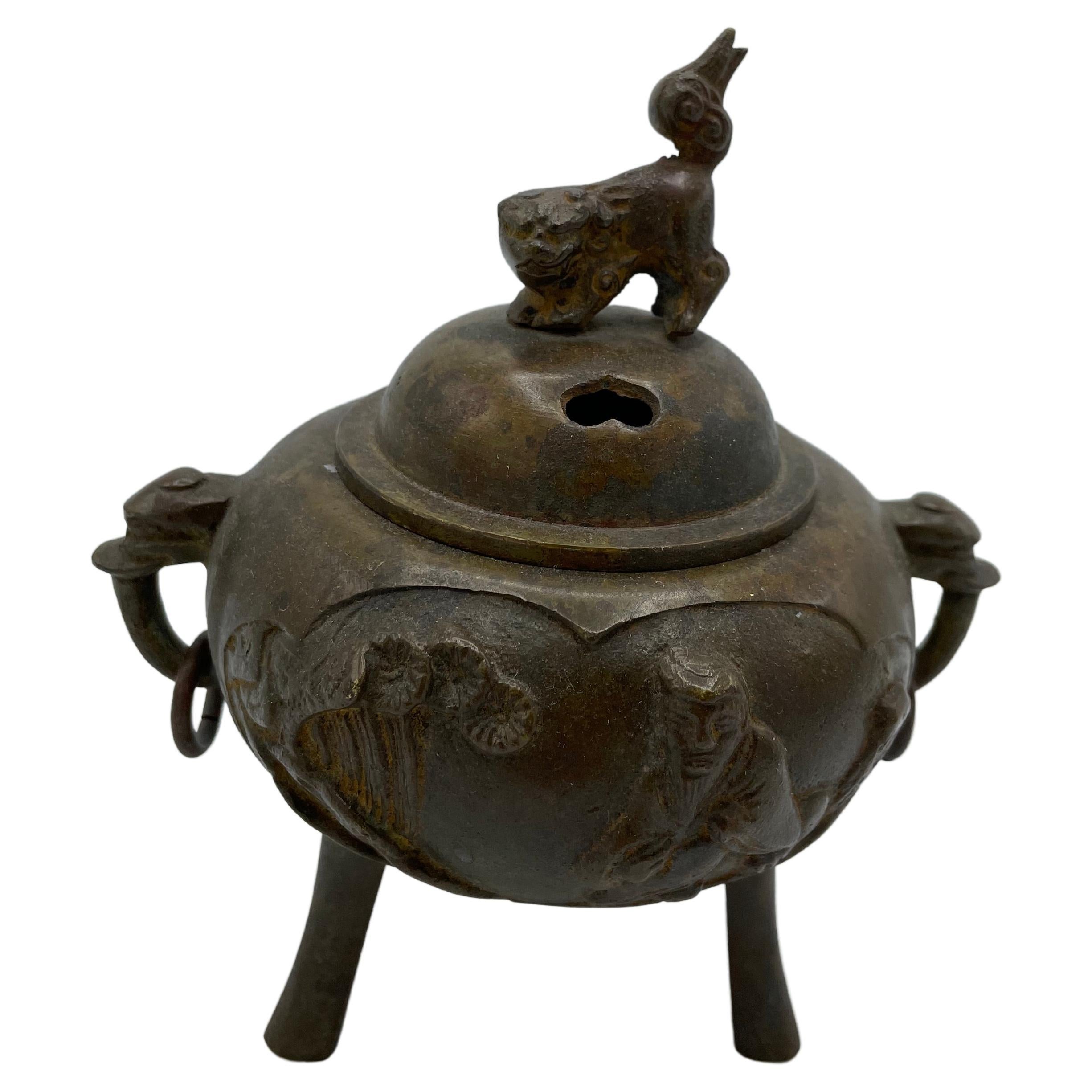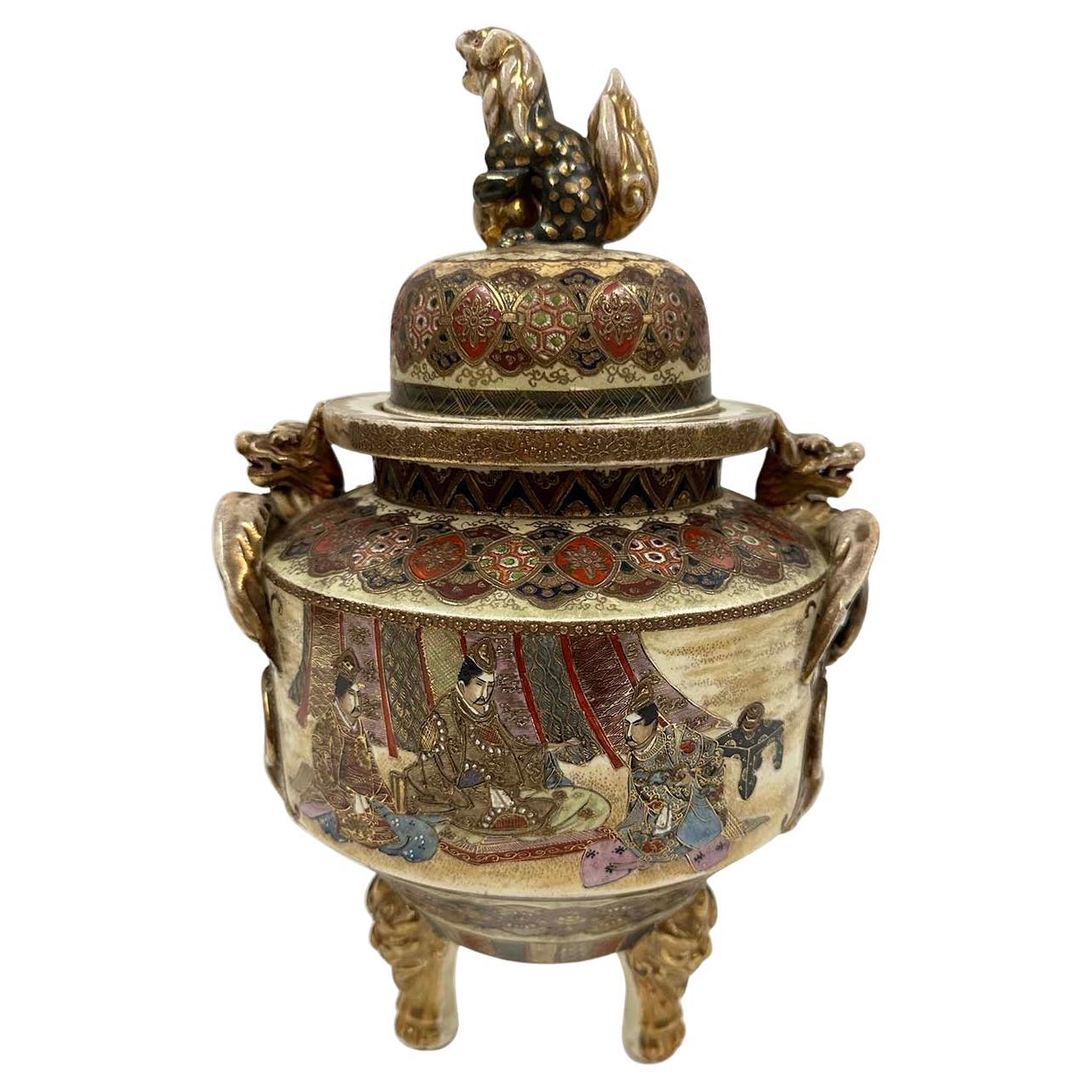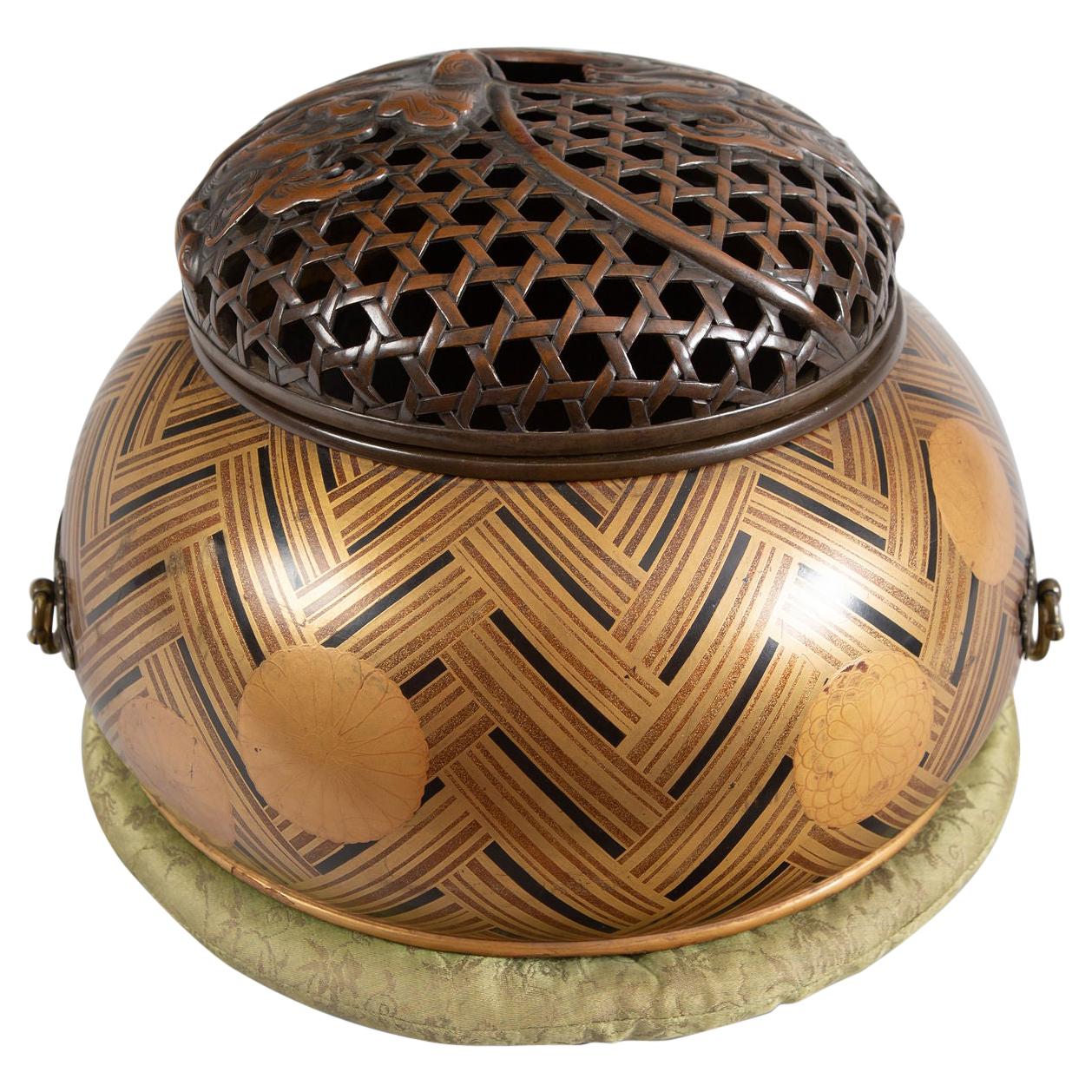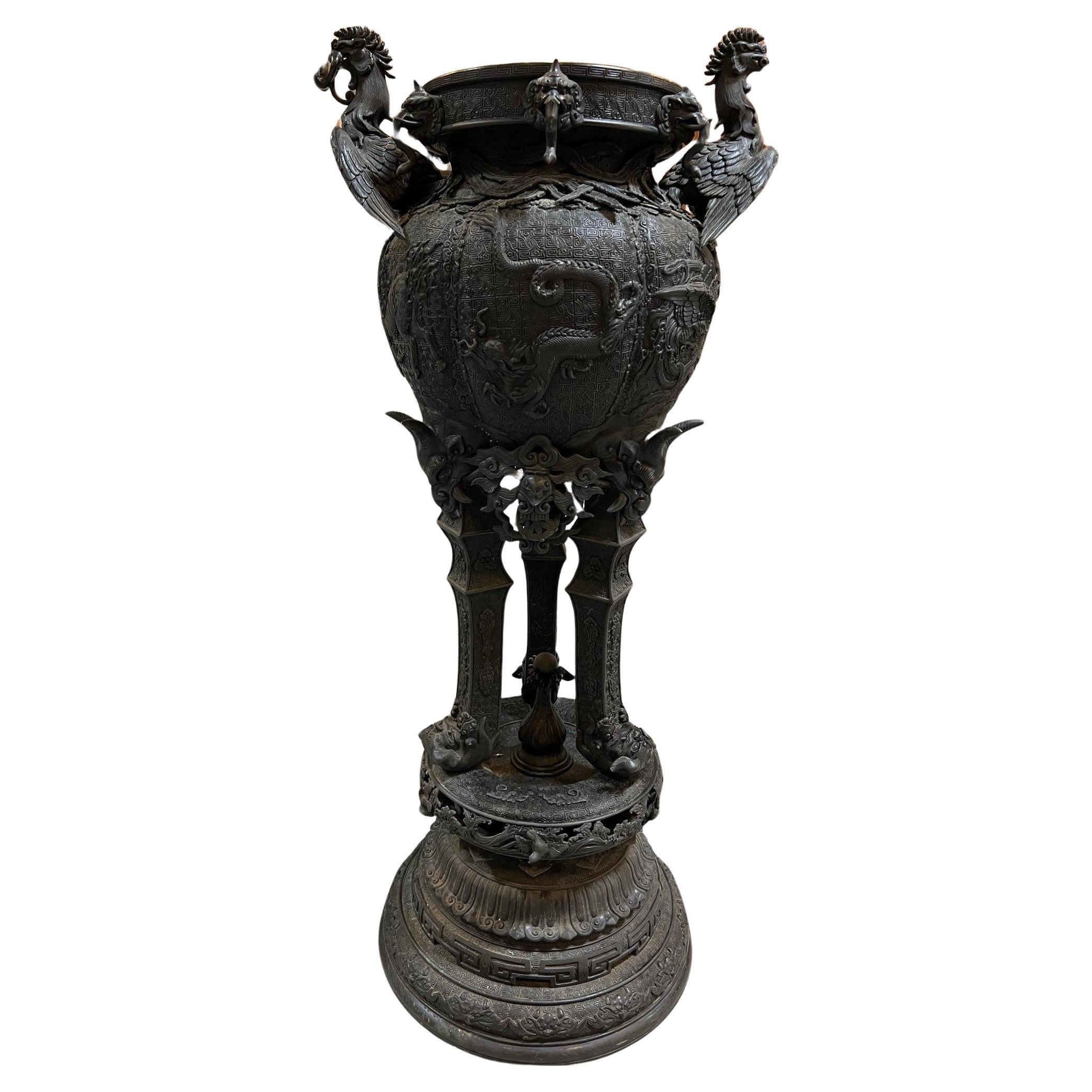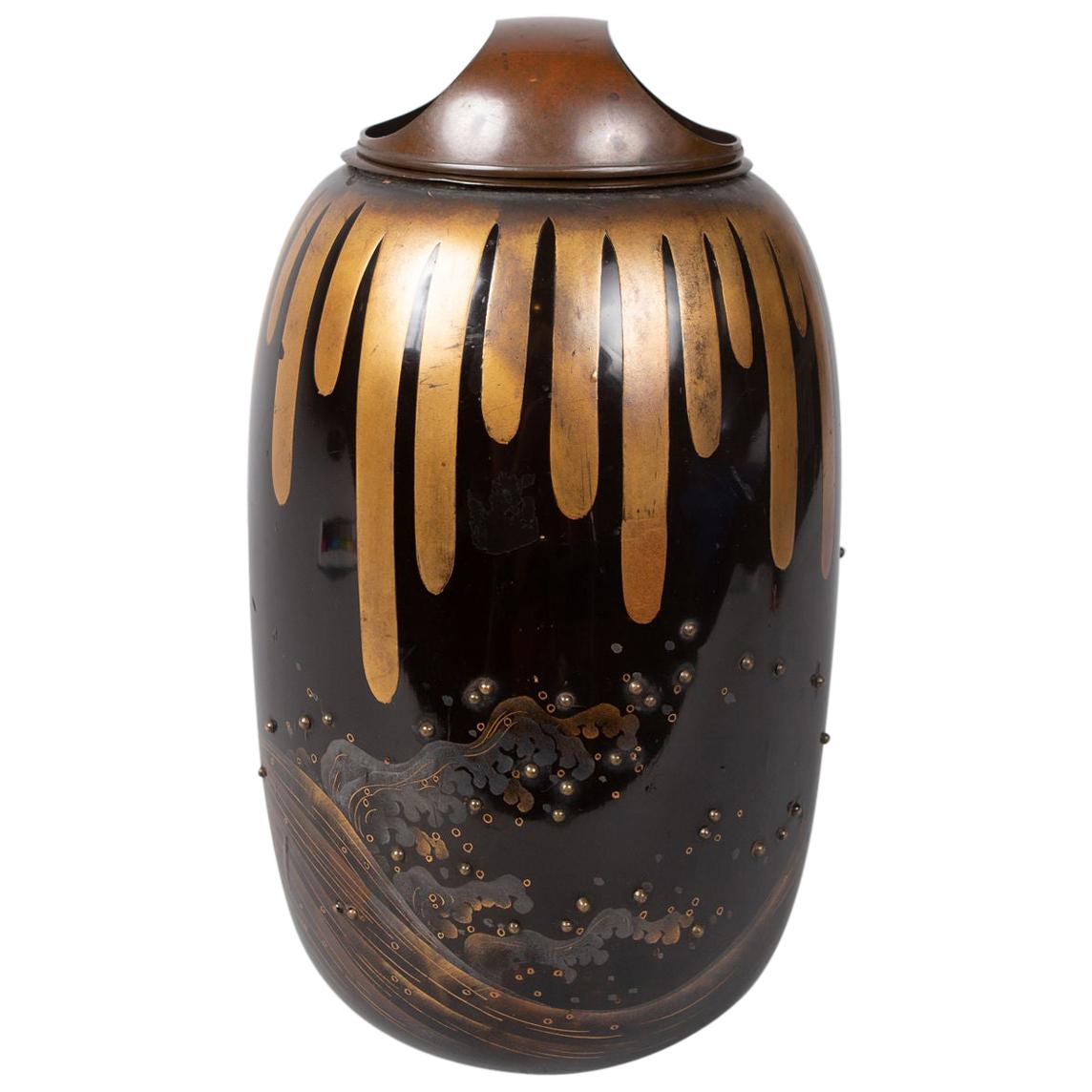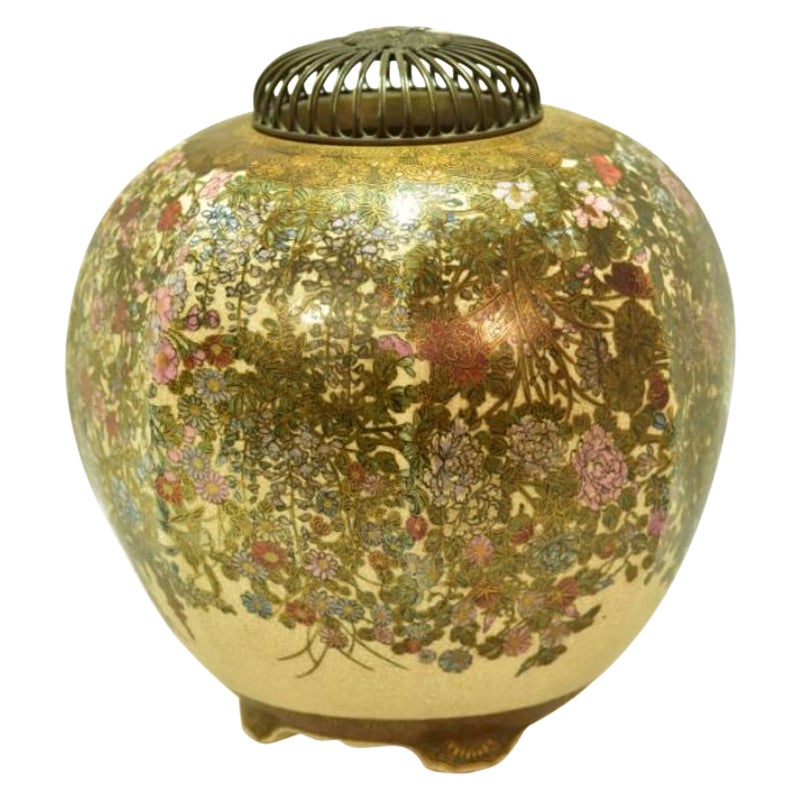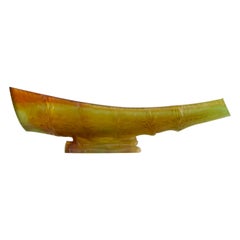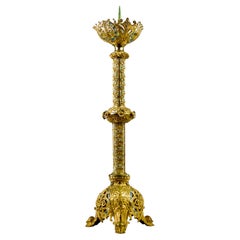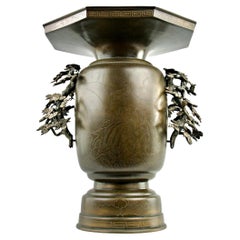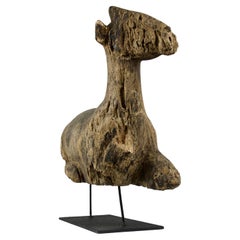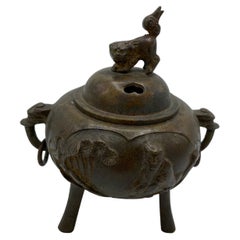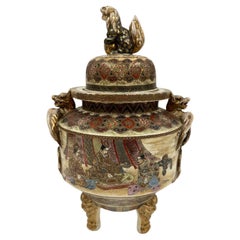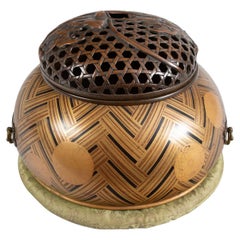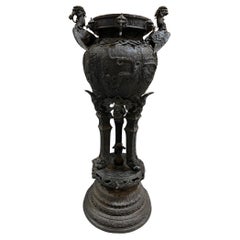Items Similar to Incense Burner, Japan, 19th Century
Want more images or videos?
Request additional images or videos from the seller
1 of 14
Incense Burner, Japan, 19th Century
$4,326.50
£3,240.21
€3,650
CA$6,064.67
A$6,681.85
CHF 3,458.93
MX$80,451.25
NOK 43,798.45
SEK 41,145.87
DKK 27,796.89
About the Item
Beautiful incense burner in the shape of a straw basket with a praying mantis sitting on top. Bronze, Japan 19th century.
Good condition, oxidation, one leg missing from the praying mantis.
Dimensions in cm ( H x L x l ) : 26 x 14.5 x 11.5
Secure shipping.
- Dimensions:Height: 10.24 in (26 cm)Width: 5.71 in (14.5 cm)Depth: 4.53 in (11.5 cm)
- Style:Meiji (Of the Period)
- Materials and Techniques:
- Place of Origin:
- Period:
- Date of Manufacture:1900
- Condition:Wear consistent with age and use. Minor structural damages.
- Seller Location:PARIS, FR
- Reference Number:1stDibs: LU8131233011822
About the Seller
5.0
Vetted Professional Seller
Every seller passes strict standards for authenticity and reliability
Established in 2020
1stDibs seller since 2023
19 sales on 1stDibs
Typical response time: <1 hour
- ShippingRetrieving quote...Shipping from: PARIS, France
- Return Policy
Authenticity Guarantee
In the unlikely event there’s an issue with an item’s authenticity, contact us within 1 year for a full refund. DetailsMoney-Back Guarantee
If your item is not as described, is damaged in transit, or does not arrive, contact us within 7 days for a full refund. Details24-Hour Cancellation
You have a 24-hour grace period in which to reconsider your purchase, with no questions asked.Vetted Professional Sellers
Our world-class sellers must adhere to strict standards for service and quality, maintaining the integrity of our listings.Price-Match Guarantee
If you find that a seller listed the same item for a lower price elsewhere, we’ll match it.Trusted Global Delivery
Our best-in-class carrier network provides specialized shipping options worldwide, including custom delivery.More From This Seller
View AllEmilio Robba for Daum, Bamboo Vase, France 2000s
By Daum, Emilio Robba
Located in PARIS, FR
Beautiful bamboo vase by Emilio Robba for the Daum Maison, France 2000s. Signed by the artist and manufacture.
In very good condition, in its original box, the box has some wear.
Dimensions in cm ( H x L x l ) : 6.8 x 21 x 6
Secure shipping
The collaboration between Emilio Robba and the prestigious glassworks Daum is an exquisite fusion of two distinct artistic worlds, uniting the delicacy of nature captured by Robba and Daum's legendary expertise in crafting exceptional glass pieces.
Emilio Robba, renowned for his talent in capturing natural beauty through his floral creations, brings his refined aesthetic and artistic sensitivity to this unique collaboration. His ability to transform nature into timeless works of art finds new expression in the medium of glass.
On the other hand, the glassworks Daum, with decades of experience and unmatched craftsmanship, breathes life into Emilio Robba's floral visions with unparalleled precision and mastery. Each piece created in collaboration reveals a perfect harmony between the delicacy of botanical forms and the crystalline transparency of glass.
Together, Emilio Robba and Daum transcend the boundaries of traditional floral art...
Category
21st Century and Contemporary French Art Nouveau Vases
Materials
Glass
Candle Stick, France, 19th Century
Located in PARIS, FR
Superb church altar candlestick of the Romantic period. Decorations in gold leaf and blue and white enamel of flowers, fleur-de-lys (symbol of the French royal house) and rams at the...
Category
Antique 19th Century French Romantic Candlesticks
Materials
Bronze, Gold Leaf
Japanese Silver Inlay Samuraï and Dragon Vase, Japan, 19th Century
Located in PARIS, FR
Beautiful and rare Japanese vase from the 19th century. Superb silver inlay work showcasing a Samuraï fighting off a serpentine dragon with an additional dragon on top of the lid. Additional detailed decorations of chrysanthemums and lily motifs.
This vase was part of the collection of Marechal Niel...
Category
Antique 19th Century Japanese Antiquities
Materials
Silver, Bronze
Han Dynasty, Laying Doe Wood Sculpture, China 100AD
Located in PARIS, FR
Superb sculpture of a laying doe from the Chinese Han Dynasty (206BC-220AD). Remainders of polychromic paint, namely red, symbol of good fortune and joy as well as the season of summer, and green, symbol of vigor and vitality and the season of spring. Mounted on base.
A similar sculpture in bronze is kept at the Met Museum with the following description " A low bed, small table, and screen were often the only furnishings in a Han-dynasty room. The floors were generally covered with mats kept in place with weights in the shape of single animals, fighting beasts, or entertainers."
Condition seen in pictures.
Dimensions in cm ( H x L x l ) :
- Sculpture : 35 x 40 x 10
- With base : 45.5 x 44 x 15
The Han Dynasty ruled China from 206 B.C. to 220 A.D. and was the second imperial dynasty of China. It is known for its promotion of Confucianism as the state religion and opening the Silk Road trade route to Europe, permanently altering the course of Chinese history. Han Dynasty art and inventions like paper still influence the world today.
From the Han Dynasty to the present, deer can be found in many materials and media—rock crystal, nephrite, ink on paper, porcelain, cloisonné enamel, jade, bamboo root, textile, bronze, etc.—alone or in groups, among trees and rocks and in various positions. They appear on everyday objects, from boxes to incense burners, incense holders, lamps, mirror holders and the droppers scholars used when they wrote. A symbol of longevity and grace in Chinese mythology, the word deer is pronounced lu, a homonym for emoluments—favors granted to officials. They therefore represent wealth, nobility and success in imperial examinations (civil service exams for selecting candidates for the state bureaucracy in Imperial China).
Deer were the faithful companions of Shu Lao, the god of longevity, and the goddess Magu. They were reputed to live long and to be the only creature able to find the mushroom of immortality, linghzhi. Although its spots are different, deer are sometimes confused or associated with stags, a Manchu hunting trophy whose antlers served to make prestigious furniture. (La Gazette Drouot, Claire Papon)
For the colours found on this piece, in Chinese culture, red symbolizes good fortune and joy. Green, symbolizes the spring when everything is brimming over with vigor and vitality.
The Han Dynasty (206 B.C. to 220 A.D.) continued the Qin Dynasty’s use of dark colours, but incorporated red. During the earlier years, or Western Han Dynasty, ordinary people wore red while court dress was black. Shoes were red in color. The clothing worn for sacrificial rites was black edged with red. In the later Eastern Han Dynasty, red symbolized the dynasty’s “fire Virtue” and became predominant. Court dress was red. Sacrificial rites called for a red-edged white layer under robes with red socks...
Category
Antique 15th Century and Earlier Chinese Han Mounted Objects
Materials
Wood
Gustave Tiffoche, Long Vase, France Design, Late 20th Century
By Gustave Tiffoche
Located in PARIS, FR
Superb Gustave Tiffoche ceramic stoneware long vase. Striated decorations and small handles on the side punctuated by colourful hues of yellow, brown and white.
Dimensions in cm ( H x D ) : 29.2 x 14
In excellent condition.
Secure shipping.
Gustave Tiffoche is one of the great French stoneware artists of the late 20th century. He started his earthenware works at the age of 33.
"In 1961, Tiffoche made his first approach to pottery at Norbert Pierlot, in Ratilly. That year the gallery of the Castle exposes the great names of the ceramics world: Bernard Leach, Shoji Hamada, Raîja Tuumi, A.Cumella, Daniel de Montmollin, Georges Jouve, M. and Y. Mohy, Jean and Jacqueline Lerat, De Vinck. He met and became friends with several of them along the way.
Two years later, he set up his workshop in Guérande. He began to produce unique pieces in parallel with a production of utilitarian pieces and built his first wood-fired kiln in 1963.
In 1966, he participated for the first time in a ceramics exhibition at the Hôtel de Sens in Paris, then at the Maison de la Culture in Caen, "Les Potiers contemporains".
He organized his first personal exhibition of ceramics in 1968 at the "Michel Columb" gallery of Marie-Jo Marot in Nantes. On the walls, the paintings are of Gaston Chaissac. Exhibits came one after another afterwards, throughout France and abroad: Stuttgart in 1969, Montreal in 1970, Munich in 1971, Faienza in 1972, Dakar in 1984 and Sarrelouis in 1994. At the same time, regular exhibitions at the "convergence" gallery in Nantes allow the artist to continue his artistic evolution and questioning.
He created a monumental ceramic fountain for the IUT in Saint-Nazaire in 1981. Other monumental works in stoneware will follow in La Roche-sur-Yon, Niort, Melle, Rennes, Bouaye, IRESTE of Nantes...
Between 1970 and 1985, many young ceramists came to learn or perfect their craft, or collaborated directly with him by working in his workshop. Among them, of note: Jorgen Hansen...
Category
Vintage 1970s French Mid-Century Modern Vases
Materials
Ceramic
Gustave Tiffoche, Tulip Vase, France, Late 20th Century
By Gustave Tiffoche
Located in PARIS, FR
Superb Gustave Tiffoche ceramic stoneware tulip vase. Freeform decorations punctuated by colourful hues of blues, browns and whites.
Dimensions in cm ( H x D ) : 28 x 12
In excellent condition.
Secure shipping.
Gustave Tiffoche is one of the great French stoneware artists of the late 20th century. He started his earthenware works at the age of 33.
"In 1961, Tiffoche made his first approach to pottery at Norbert Pierlot, in Ratilly. That year the gallery of the Castle exposes the great names of the ceramics world: Bernard Leach, Shoji Hamada, Raîja Tuumi, A.Cumella, Daniel de Montmollin, Georges Jouve, M. and Y. Mohy, Jean and Jacqueline Lerat, De Vinck. He met and became friends with several of them along the way.
Two years later, he set up his workshop in Guérande. He began to produce unique pieces in parallel with a production of utilitarian pieces and built his first wood-fired kiln in 1963.
In 1966, he participated for the first time in a ceramics exhibition at the Hôtel de Sens in Paris, then at the Maison de la Culture in Caen, "Les Potiers contemporains".
He organized his first personal exhibition of ceramics in 1968 at the "Michel Columb" gallery of Marie-Jo Marot in Nantes. On the walls, the paintings are of Gaston Chaissac. Exhibits came one after another afterwards, throughout France and abroad: Stuttgart in 1969, Montreal in 1970, Munich in 1971, Faienza in 1972, Dakar in 1984 and Sarrelouis in 1994. At the same time, regular exhibitions at the "convergence" gallery in Nantes allow the artist to continue his artistic evolution and questioning.
He created a monumental ceramic fountain for the IUT in Saint-Nazaire in 1981. Other monumental works in stoneware will follow in La Roche-sur-Yon, Niort, Melle, Rennes, Bouaye, IRESTE of Nantes.
Between 1970 and 1985, many young ceramists came to learn or perfect their Craft, or collaborated directly with him by working in his workshop. Among them, of note: Jorgen Hansen...
Category
Vintage 1970s French Mid-Century Modern Vases
Materials
Ceramic
You May Also Like
Antique Japanese Incense Burner with Iron in 1920s Taisho Era
Located in Paris, FR
This incense burner was made in 1920s (Taisho era) in Japan.
On the top, there is a Komainu (Lions that guard the entrance or the honden of sanctuaries).
It can use as incense burne...
Category
Vintage 1920s Japanese Taisho Animal Sculptures
Materials
Iron
Antique Japanese Meiji Period Satsuma Incense Burner Censer
Located in Pomona, CA
UP for you consideration is a beautiful antique Meiji period Japanese gold gilt satsuma incense burner marked/signed by Kinkozan. Very fine hand...
Category
Early 20th Century Japanese Chinese Export Urns
Materials
Porcelain
Early 17th century 'Incense Burner' ( Koro)
Located in Hudson, NY
Early 17th century incense burner( Koro) in basket weave nashiji lacquer pattern with chrysanthemum mons (the national symbol of Japan). Copper grill with detailed waves pattern. Foo...
Category
Antique Early 17th Century Japanese Lacquer
Materials
Copper
Large Antique Japanese Bronze Koro or Incense Burner
Located in Stamford, CT
Dating from the Meiji period this standing Japanese Koro or incense burner has a circular stepped base. Three legs topped with horned and other demons st...
Category
Antique Late 19th Century Japanese Metalwork
Materials
Bronze
$4,800 Sale Price
20% Off
Japanese Lacquer Koro 'Incense Burner'
Located in Hudson, NY
Removable bronze top, with gold drip pattern at top. Cresting ocean waves on bottom with raised silver sea spray.
Category
Antique Early 19th Century Japanese Edo Lacquer
Materials
Silver, Bronze
Incense Burner in Satsuma Earthenware
Located in Marseille, FR
JAPAN - Circa 1900 Incense burner in Satsuma earthenware with vegetal decoration. Openwork lid in shibuichi surmounted by a flower in slight relief...
Category
Antique 19th Century Japanese More Asian Art, Objects and Furniture
Materials
Earthenware
More Ways To Browse
19th Century Japanese Bronze Vases
Japan Vase Mid Century
Japanese Meiji Bronze Vessel
Praying Mantis
Japanese Bronze Urn
Antique Japanese Bronze Urn
Meiji Bronze Urn
Urn Trophy
Sevres Porcelain Pair Urns
Urns On Stands
Green Urn Vase
Antique Bird Urns
Large Black Urn
Rams Heads Urn
Sevres Style Urns
Tole Urns
Black Porcelain Urns
French Urns White
